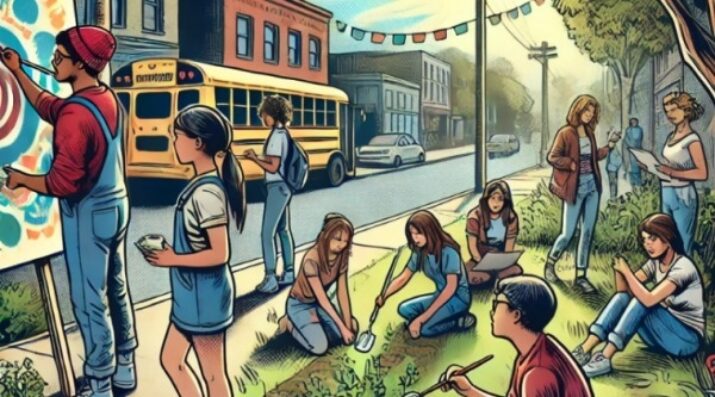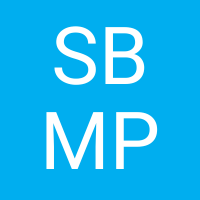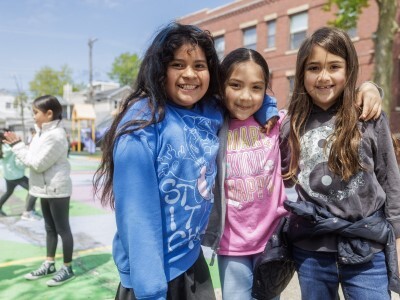7 School Design Principles for Education's Next Horizon
Topics

Today’s learners face an uncertain present and a rapidly changing future that demand far different skills and knowledge than were needed in the 20th century. We also know so much more about enabling deep, powerful learning than we ever did before. Our collective future depends on how well young people prepare for the challenges and opportunities of 21st-century life.
Schools, districts, educators, students, and organizations at the edges are already proving what a new, currently relevant education could be—one where knowledge is learned in order to be able to do things in the world, rather than primarily take tests.
Education is always an abstraction, prioritizing some things while leaving others out. The system many are doubling down on or tinkering around the edges of is a 19th-century blueprint, built around fixed subjects, standardized tests, and age-based progression. At its core are content standards—defining what every student should know and when—shaped by an era when mass education functioned to sort students into largely predefined roles in society.
But in an age of AI and automation, a new abstraction is needed—one that values agency, adaptability, creativity, critical thinking, and the ability to learn, unlearn, and relearn. While the system reinforces the old model, this series has sought to highlight schools, districts, educators, students, and organizations at the edges who are already proving what a new, currently relevant abstraction for education could be—one where knowledge is learned in order to be able to do things in the world, rather than primarily take tests.
While the standardized model remains dominant, forward-thinking schools, educators, and communities are redefining education. These models, some new and some which have been around for decades embrace curiosity, adaptability, relevance, and student agency, moving beyond the constraints of the 19th-century blueprint. They look at the purpose of education first and foremost as human development, and they seek to develop young people into continually learning, thriving adults with strong personal and peer relationship skills, sustaining careers, and a commitment to civic engagement.
Below are 7 design principles for H3 learning environments that we extracted from the 24 different stories in this series. You can navigate the resource(s) by clicking on the blogs related to each topic.
To move to the next horizon of learning, we must shift…
- From Fixed Standards to Competency-Based Mastery
- From One-Size-Fits-All to Adaptive Learning
- From Prescribed Knowledge to Innovation & Inquiry
- From Subjects as Silos to Transdisciplinary, Real-World Learning
- From Schools as Self-Contained to Schools as Embedded in Communities
- From Standardized Testing to Meaningful Assessment
- From Institutional Ownership of Student Data to Student-Controlled Learning Wallets

1. From Fixed Standards to Competency-Based Mastery
Shifting from fixed standards to competency-based mastery ensures true growth for learners and heightened relevance.
Mathematics
Instead of a narrow emphasis on algebra and calculus, H3 models prioritize real-world numeracy—data science, probability & statistics, and computational thinking—and experiential pedagogy from early childhood on.
Literacy
Students engage in multimodal literacy, analyzing AI-generated content, synthesizing digital and visual data, and creating across platforms.
Explore Competency-Based Mastery
- How Generative AI Can Enable and Accelerate H3 School Transformation - Collectively, we need to redesign our education system to enable all of our children—and, by extension, our nation—to thrive today and tomorrow.
- What Should Young People Get Really Good At? - Schools should prioritize fostering creativity and problem-solving skills to maintain the genius-level creativity seen in young children.
- Agency for nine-month-olds? Yes! - Inquiry-based learning and provocation-rich settings support early childhood development by fostering agency and deeper learning.

2. From One-Size-Fits-All to Adaptive Learning
H3 education shifts from rote, non-personalized to flexible models that meet students where they are at.
Grade Levels
H3 education moves away from fixed grade levels, prioritizing learning that is personalized, flexible, and designed for mastery over seat time.
- Kentucky’s Learning Ecosystem in 2040: A Day in the Life - Education systems can be reimagined to prioritize student agency, real-world learning, and equity, supported by AI and community involvement.
- Centering Learners by Design: Shaping the Future of Education - Engaging parents, youth, teachers, principals, district leaders, community members, and industry experts in the co-design process ensures that education systems align with the aspirations and needs of the community.
Pathways
Instead of rigid academic tracks, students design their own learning pathways, integrating hands-on projects, internships, and problem-solving experiences.
- Igniting the Flame: How Motivation Catalyzes Student Potential in Horizon 3 Education - Intrinsic motivation and student agency from real-world engagement and personalized learning enable learners to pursue their interests and develop essential skills for the future.
- 6 Characteristics of an Education that Students Want - Students at the School of Industrial Design, Engineering and Arts (IDEA) in Tacoma, Washington, share what they want as high school students.

3. From Prescribed Knowledge to Innovation & Inquiry
Making the shift from knowledge transfer to inquiry helps prepare young people to enter the world by equipping them with agency, new mindsets and the ability to use new tools.
Agency
Even infants demonstrate agency, meaning schools should be designed to cultivate curiosity, independence, and creative problem-solving from the very start and all the way through. They should also engage young people in their design.
- Centering Learners by Design: Shaping the Future of Education - Engaging parents, youth, teachers, principals, district leaders, community members, and industry experts in the co-design process ensures that education systems align with the aspirations and needs of the community.
- Igniting the Flame: How Motivation Catalyzes Student Potential in Horizon 3 Education - Intrinsic motivation and student agency from real-world engagement and personalized learning enable learners to pursue their interests and develop essential skills for the future.
- 6 Characteristics of an Education that Students Want - Students at the School of Industrial Design, Engineering and Arts (IDEA) in Tacoma, Washington, share what they want as high school students.
- How to Design Schools to Grow Thriving Adults: A Provocation - Focusing on processes such as design thinking, engineering design, and the scientific method equips students with practical skills to thrive in real-world scenarios.
- Shifting to an H3 Mindset Starts With Believing in the Power of Students - Students taking an active role in their education—being involved in decision-making, curriculum design, and school policy—requires a fundamental change in how adults perceive students and their capabilities.
- The Flight School: Reimagining the Path to Adulthood - The Flight School redefines the educational journey as a “launch year” that emphasizes self-discovery and essential human skills, preparing students for a rapidly evolving future.
- Agency for nine-month-olds? Yes! - Inquiry-based learning and provocation-rich settings support early childhood development by fostering agency and deeper learning.
New Mindsets
Instead of passive learning, H3 schools cultivate creative problem-solvers, emphasizing entrepreneurial thinking, design methodologies, and applied STEM—for students, teachers, leaders and all adults in the system.
- 6 Characteristics of an Education that Students Want - Students at the School of Industrial Design, Engineering and Arts (IDEA) in Tacoma, Washington, share what they want as high school students.
- Transforming Teaching in Ohio's Largest School District - A fellowship that emphasizes real-world problem-solving and collaborative teaching significantly boosts student engagement and teacher satisfaction.
- How to Design Schools to Grow Thriving Adults: A Provocation - Focusing on processes such as design thinking, engineering design, and the scientific method equips students with practical skills to thrive in real-world scenarios.
- How We Lead the Change Is the Change: Horizon 3 Leadership - Horizon 3 leaders must embrace new mindsets and practices to navigate complexity and uncertainty while co-creating equitable, innovative learning environments with diverse communities of people in and outside of school.
AI & Automation
AI and automation reshape learning—students focus on how to think, analyze, and create rather than just recall information.
- How Generative AI Can Enable and Accelerate H3 School Transformation - Collectively, we need to redesign our education system to enable all of our children—and, by extension, our nation—to thrive today and tomorrow.

4. From Subjects as Silos to Transdisciplinary, Real-World Learning
Making the shift to transdisciplinary, real-world learning helps make learning more durable, more relevant and more transferable.
Real-World Learning
Students solve complex, real-world problems across disciplines rather than isolated subject blocks where High Quality Instructional Materials don’t mean scripted curricula but rather meaningful, rigorous projects designed by adults and students with AI support.
- What Should Young People Get Really Good At? - Schools should prioritize fostering creativity and problem-solving skills to maintain the genius-level creativity seen in young children.
- 6 Characteristics of an Education that Students Want - Students at the School of Industrial Design, Engineering and Arts (IDEA) in Tacoma, Washington, share what they want as high school students.
- Igniting the Flame: How Motivation Catalyzes Student Potential in Horizon 3 Education - Intrinsic motivation and student agency from real-world engagement and personalized learning enable learners to pursue their interests and develop essential skills for the future.
- How to Design Schools to Grow Thriving Adults: A Provocation - Focusing on processes such as design thinking, engineering design, and the scientific method equips students with practical skills to thrive in real-world scenarios.
- How Generative AI Can Enable and Accelerate H3 School Transformation - Collectively, we need to redesign our education system to enable all of our children—and, by extension, our nation—to thrive today and tomorrow.
Inquiry-Based Learning
Learning is structured around big questions and challenges, such as sustainability, AI ethics, and entrepreneurship, rather than rigid subjects and grounded in past, present, future, and place.
- 6 Characteristics of an Education that Students Want - Students at the School of Industrial Design, Engineering and Arts (IDEA) in Tacoma, Washington, share what they want as high school students.
- Shifting to an H3 Mindset Starts With Believing in the Power of Students - Students taking an active role in their education—being involved in decision-making, curriculum design, and school policy—requires a fundamental change in how adults perceive students and their capabilities.
- A New Operating System for Public Education: Learner-Centered Ecosystems - Learner-centered ecosystems integrate community resources and focus on holistic outcomes to adapt and thrive, meeting diverse student needs.
- Our Past, Present, and Future - NACA’s model emphasizes community involvement to create educational environments that are authentic, purposeful, and rooted in Indigenous values.

5. From Schools as Self-Contained to Schools as Embedded in Communities
Shifting from self-contained to community embedded helps schools create accountability systems, effective pathways and partnerships and helps students feel connected to doing work that matters.
Community Partnerships
Education extends beyond the classroom into communities, leveraging local organizations, businesses, and mentors to create relevant, hands-on experiences.
- Catalyzing Educator & Student Agency through Community-Engaged Learning - Engaging community members as educators and mentors enhances student learning and supports educators. Building social capital through community-engaged learning provides equitable access to networks, crucial for both individual well-being and community success.
- A New Operating System for Public Education: Learner-Centered Ecosystems - Learner-centered ecosystems integrate community resources and focus on holistic outcomes to adapt and thrive, meeting diverse student needs.
- How We Lead the Change Is the Change: Horizon 3 Leadership - Horizon 3 leaders must embrace new mindsets and practices to navigate complexity and uncertainty while co-creating equitable, innovative learning environments with diverse communities of people in and outside of school.
- Getting H3 Right: Critical Recommendations for Funders and Policymakers - H3 learning environments must operate independently from conventional H1 policies to truly innovate and thrive. ;Continuous improvement and integration of H3 ecosystems are essential for mainstream adoption, requiring tailored solutions.
Lifelong Learning
Schools act as hubs for lifelong learning, connecting students with professionals, civic leaders, and emerging industries as well as communities’ histories and wisdom.
- Our Past, Present, and Future - NACA’s model emphasizes community involvement to create educational environments that are authentic, purposeful, and rooted in Indigenous values.
- Igniting the Flame: How Motivation Catalyzes Student Potential in Horizon 3 Education - Intrinsic motivation and student agency from real-world engagement and personalized learning enable learners to pursue their interests and develop essential skills for the future.

6. From Standardized Testing to Meaningful Assessment
Shifting from standardized assessment to meaningful assessment lets learners demonstrate knowledge in ways that work for them, frequently resulting in higher-quality demonstrations of learning.
Accountability
H3 accountability focuses on performance-based learning, where students demonstrate knowledge through portfolios, capstone projects, and real-world applications.
Assessment
Rather than compliance-driven testing, assessment systems support continuous growth and adaptability—aligning with how learning actually happens.
Explore Accountability and Assessment
- To Fully Realize Horizon Three, We Need New Accountability Systems - Accountability systems should encourage innovation and local community participation, aligning with learners’ needs and strengths. Reciprocal accountability ensures all stakeholders share responsibility for educational outcomes.
- Igniting the Flame: How Motivation Catalyzes Student Potential in Horizon 3 Education - Intrinsic motivation and student agency from real-world engagement and personalized learning enable learners to pursue their interests and develop essential skills for the future.
- 5 Solutions to the Biggest Obstacles in Transforming Public Schools - To transform school systems, leaders must build a robust leadership pipeline, foster a collaborative culture, and be prepared to adapt to change. And transformation efforts should include all staff, not just teachers and principals.
- A New Infrastructure for Learning Credentials - Full implementation and acceptance of new education models requires an explicit and collective rewrite of our current mental infrastructure.

7. Shift from Institutional Ownership of Student Data to Student-Controlled Learning Wallets
In the current system, schools own transcripts, test scores, and credentials. Students must request permission to access their learning records. In order to transform this system, we must develop digital, portable learning records controlled by students. This can be done the following ways:
Launch Student-Owned “Learning Wallets”
The Mastery Transcript Consortium (MTC) is already proving that students don’t need traditional GPAs or credit hours to get into college—they’re using alternative records based on competency and skills.
- A New Infrastructure for Learning Credentials - Full implementation and acceptance of new education models requires an explicit and collective rewrite of our current mental infrastructure.
Move from Diplomas to Portraits of a Graduate
In Kentucky and South Carolina’s Portrait of a Graduate frameworks shift from traditional diplomas to competency-based models that prioritize real-world skills.
- 5 Solutions to the Biggest Obstacles in Transforming Public Schools - To transform school systems, leaders must build a robust leadership pipeline, foster a collaborative culture, and be prepared to adapt to change. And transformation efforts should include all staff, not just teachers and principals.
- Kindling the Spark: How the Portrait of a Graduate Becomes the Catalyst for Transformation - Incorporating diverse community and student voices in developing a Portrait of a Graduate ensures it reflects local values and needs; successful implementation of a Portrait of a Graduate requires teacher buy-in and support through professional learning and accessible resources.
- One Goal, Two Journeys: The Role of Community and Workforce in Defining Graduate - Kentucky and South Carolina were pioneers in taking a bold new look at what it means to be a prepared graduate, developing state-level frameworks to clarify what students need to succeed beyond high school.
Make Learning Achievements Badgeable, Stackable and Make Transcripts an Open-Source Tool
Grand Valley State University (MI) is developing a pilot for a digital wallet across K12 and higher ed in Grand Rapids, and the state of North Dakota has launched a digital wallet system where badges and credentials travel with students, making learning more fluid and borderless.
- A New Infrastructure for Learning Credentials - Full implementation and acceptance of new education models requires an explicit and collective rewrite of our current mental infrastructure.

The Shift is Happening...
While traditional models persist, these H3-aligned approaches are already being built, tested, and iterated upon. The challenge is no longer primarily in imagining what the future of education could look like. It’s in spreading innovation to more places which entails:
- More schools or microschools designing, building, and testing H3 models in their local contexts (inside existing schools, in alternative education schools, in new schools). This includes partnering with tech, community organizations, and technical assistance providers to make new learning experiences easier to design and manage, both for young people and adults.
- Modularizing the pieces that work, integrating them together, and enabling them to be put together in different ways in different contexts, testing them in different contexts, and sharing what works.
- Networking innovators to problem-solve together, borrow from each other, as well as spread awareness of the new design pieces so that everyone everywhere isn’t reinventing the wheel.
- Funding for all this work.
…Unevenly
It also remains true that the most comprehensively innovative of the models—The Growing Place, One Stone, The Flight School, Red Bridge, for example—all too often are private. Founders often intentionally choose to make them private because of freedom from constraints. This independence allows them to experiment boldly with pedagogy, assessment, and governance in ways that traditional public systems don’t permit. However, this also means that the students who might benefit most from these innovations are often the least likely to access them.
Check out the 5 moves teachers, leaders, policymakers, legislators, and funders need to make to overcome constraints to make future-ready learning accessible for all: 5 Systemic Moves for Making Next Horizon (H3) a More Widespread Reality.

This blog series was sponsored by LearnerStudio, a non-profit organization accelerating progress towards a future of learning where young people are inspired and prepared to thrive in the Age of AI—as individuals, in careers, in their communities and our democracy. It was curated and edited by Sujata Bhatt and Mason Pashia.
This article originally appeared on Getting Smart in March 2025. All images courtesy of Getting Smart.




